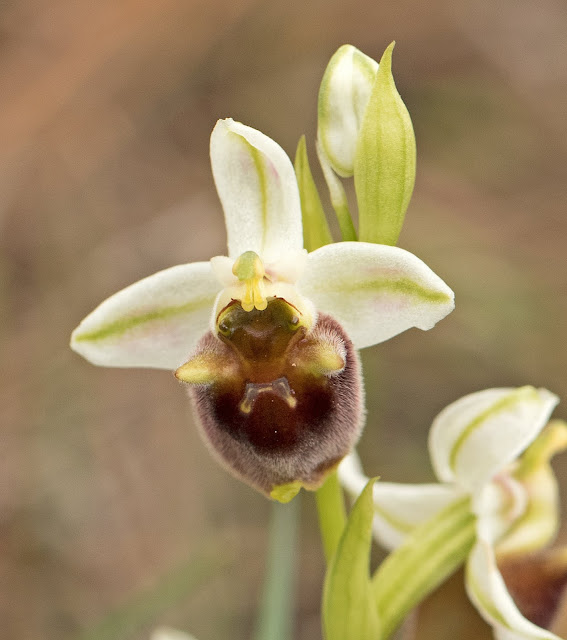Saturday 2nd March - Anarita Park and the Pegeia Forest
Well it just goes to show that you can plan everything but if Mother Nature intervenes then you are stuffed. After a hearty breakfast I hit the road, destination Anarita Park and the TV mast. Target for today was to be Wheatears and any other winter residents that I could find. Sadly, as I turned off the main road, heading for Loukaides Chicken Farm, it became apparent that I was in trouble. The winter rains had turned all the side tracks into a quagmire of red mud. Already, after only a short distance my pristine white rent-a-hide had become plastered in red mud and the upper parts were turning a delicate shade of pink.
I persevered and made it beyond Anarita village where a couple of Hoopoes laughed at me and sundry larks chortled, as I slithered about - even on the metalled roads. I gave up, did a 180 degree turn and headed off for the Pegeia Forest - perhaps a search for Orchids would be more profitable.
I made the picnic area car park before midday and the weather was holding up, occasional bursts of sunshine and even the temperature was rising. I set off into the forest and was soon surrounded by orchids, more than I had ever seen before so I set about recording them.
Anacamptis syriaca, Green-winged Orchid
 |
| Anacamptis syriaca |
 |
| Anacamptis syriaca |
 |
| Pale form - almost white. |
 |
| Anacamptis syriaca |
Ophrys elegans
Ophrys cinereophila
Ophrys levantina
Orchis sezikiana
Ophrys sicula
Nice to get an Orange Tip butterfly, this one stopped to stick his proboscis in a flower and gave me just enough time for a shot.
After such a poor start I ended up having a great day, six new orchid species and a butterfly. Oddly, I heard lots of birds but saw few, probably because I was staring intently at the ground most of the time. Birding and botany are probably not the most complementary of pastimes.
Sunday 3rd March - Paphos Headland
Overnight the weather had taken a turn for the worse with heavy rain showers, not the weather for photography. The plan was to have a turn around the headland so that other members of the group, who had also arrived early, would get to see the Greater Sand Plovers. Of course with the prevailing weather there was every chance of a fall of migrants.
Late morning the weather eased and we ventured forth, whilst on the headland we met some other birders who informed us of the presence of at least two Desert Wheatears and having found them easily, we settled down among the rocks for some photography.
 |
| A damp Desert Wheatear |
 |
| Desert Wheatear |
 |
| Desert Wheatear |
 |
| Desert Wheatear |
 |
| Desert Wheatear |
 |
| Desert Wheatear |
Having satisfied ourselves with some really close shots we went in search of more subjects. Great excitement at a distant Great Spotted Cuckoo, unfortunately inside the wire fence so I could only record it, rather than make any attempt to get closer. A flock of what I think were Red-throated Pipits flitted in and out of the fenced area - not convinced - but they do have mildly russet throats.
Monday 4th March
I was up bright and early as I wanted to see if I could find the cuckoo in the archaeological area before returning my mobile hide to the airport. The group weren't due to arrive until around 1345 so I had some three hours to find my target. Sadly, I couldn't locate it. However, I was entertained by a Sardinian Warbler and I managed to record a spanking brand new, fresh out of the chrysalis, Swallowtail that was happy to pose in the morning sunlight.
 |
| Sardinian Warbler |
 |
| Sardinian Warbler |
 |
| Sardinian Warbler |
 |
| Swallowtail |
 |
| Possible Cetoniinae - Oxythyrea cinctella - a flower chafer. |
 |
| Hooded Crows are everywhere. |
 |
| Hooded Crow |
I returned the hide to Avis at the airport and then waited for the rest of the group to arrive. Paphos airport is lightly loaded at this time of year and it wasn't long before we were all aboard the minibus heading for a couple of birding stops before going to the hotel. At Mandria Beach, as I disembarked from the bus I heard the call of a Black Francolin, a bird I had never seen but before I travelled I had studied the call on Xeno-Canto. It was well hidden but I wasn't going to give up the chance of a record shot that easily. As the group drifted off into the dune slacks in search of botany, I found the highest rock to stand on to scan the fields and was rewarded with good, if distant views of the bird - life tick as they say.
 |
| Black Francolin - very vocal but distant. |
Finally another visit to the sewage plant to allow the group a sighting of the Spur-winged Plovers, yet again they were inside and hard to see. Fortunately they were spooked and provided some excellent fly-bys
























No comments:
Post a Comment